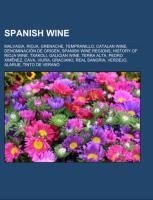
Spanish wine
Source: Wikipedia. Pages: 57. Chapters: Malvasia, Rioja, Grenache, Tempranillo, Catalan wine, Denominación de Origen, Spanish wine regions, History of Rioja wine, Txakoli, Galician wine, Terra Alta, Pedro Ximénez, Cava, Viura, Graciano, Real Sangria, Verdejo,... Viac o knihe
Produkt je dočasne nedostupný
16.81 €
bežná cena: 19.10 €
O knihe
Source: Wikipedia. Pages: 57. Chapters: Malvasia, Rioja, Grenache, Tempranillo, Catalan wine, Denominación de Origen, Spanish wine regions, History of Rioja wine, Txakoli, Galician wine, Terra Alta, Pedro Ximénez, Cava, Viura, Graciano, Real Sangria, Verdejo, Alarije, Tinto de verano, Bota bag, Parraleta, Cádiz, Sierra Norte de Sevilla, Vino de la Tierra, Campo de Cartagena, Laujar-Alpujarra, Castelló, Costa de Cantabria, Illes Balears, Sierra Sur de Jaén, Desierto de Almería, Valle del Cinca, Contraviesa-Alpujarra, Abanilla, Castilla, Barbanza e Iria, Ribera del Andarax, Valle del Miño-Orense, Cangas, Malaga, Norte de Granada, Sierras de Las Estancias y Los Filabres, Isla de menorca, Serra de Tramuntana-Costa Nord, El Terrerazo, Formentera, Norte de Almería, Ibiza, Liébana, Sierra de Alcaraz, Ribera del Jiloca, Mallorca, Ribera del Gállego-Cinco Villas, Ribera del Queiles, Bailén, Granada Sur-Oeste, Torreperogil, Valdejalón, Extremadura, Bajo Aragón, Córdoba, Albarello, Betanzos, Los Palacios, Gálvez, Pozohondo, Fondillón, Castilla y León, Valtiendas. Excerpt: Spanish wines are wines produced in the southwestern European country of Spain. Located on the Iberian Peninsula, Spain has over 2.9 million acres (over 1.17 million hectares) planted-making it the most widely planted wine producing nation but it is only the third largest producer of wine in the world, the largest being France followed by Italy. This is due, in part, to the very low yields and wide spacing of the old vines planted on the dry, infertile soil found in many Spanish wine regions. The country is ninth in worldwide consumptions with Spaniards drinking, on average, 10.06 gallons (38 liters) a year. The country has an abundance of native grape varieties, with over 400 varieties planted throughout Spain though 80 percent of the country's wine production is from only 20 grapes-including Tempranillo, Albariño, Garnacha, Palomino, Airen, Macabeo, Parellada, Xarel·lo, Cariñena and Monastrell. Major Spanish wine regions include the Rioja and Ribera del Duero which is known for their Tempranillo production; Jerez, the home of the fortified wine Sherry; Rías Baixas in the northwest region of Galicia that is known for its white wines made from Albariño and Catalonia which includes the Cava and still wine producing regions of the Penedès as well the Priorat region. The abundance of native grape varieties fostered an early start to viticulture with evidence of grape pips dating back to the Tertiary period. Archaeologists believe that these grapes were first cultivated sometime between 4000 and 3000 BC, long before the wine-growing culture of the Phoenicians founded the trading post of Cádiz around 1100 BC. Following the Phoenicians, the Carthaginians introduced new advances to the region-including the teachings of the early viticulturist Mago. Carthage would wage a series of wars with the emerging Roman Republic that would lead to the Roman conquest of the Spanish mainland, known as Hispania. Roman aqueduct built in the Castile and León city of Segovia.Under Roman rul
- Vydavateľstvo: Books LLC, Reference Series
- Formát: Paperback
- Jazyk:
- ISBN: 9781156461464


 Anglický jazyk
Anglický jazyk 



 Nemecký jazyk
Nemecký jazyk 





